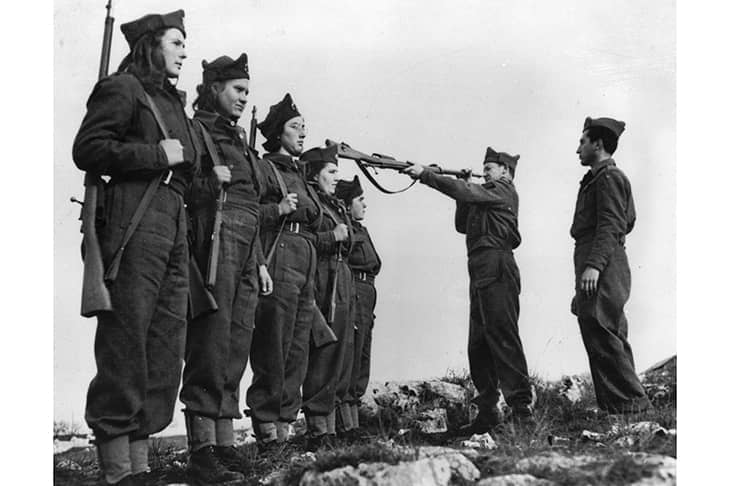When in 1941 Winston Churchill famously declared that the newly formed Special Operations Executive, set up to encourage resistance movements, would ‘set Europe ablaze’, neither he nor anyone else could have known the extent of the help the partisans would provide to the liberation of the continent. Nor, indeed, did anyone envisage the fact that not all of them would prove as biddable to Allied wishes as they hoped. As Halik Kochanski shows in her compendious book on the six-year underground war, resisters came in all shapes and sizes, not easily controlled or corralled into categories.
She divides her survey into three periods. The first runs from March 1939 and the occupation of Czechoslovakia to the German invasion of Russia in June 1941. The second carries the story up to the surrender of Italy in September 1943, the period of the maximum growth of the resistance, when the communists, held back by the Molotov-Ribbentrop pact of 1939, were freed to rise up against Moscow’s former allies. The last and perhaps most interesting section runs to the aftermath of the war, when the resistance was most organised, but also most rivalrous and disputatious about post-war politics. Looking at Europe as a whole allowed her, she says, to avoid the ‘pitfalls of nationalism’ and the epic myths of any one single country’s resistance memory. Her task was not an easy one.
Moving between France, Italy, the Balkans, Scandinavia and Eastern Europe, Kochanski charts the rise and fall of the separate movements, as they formed, developed, splintered and suffered repeated losses at the hands of the German occupiers. She looks at the uprisings in Naples, Paris and Warsaw, at SOE operations, at the role of the communists in the various resistance movements, at Jewish participation in the partisan bands and at preparations for D-Day. Where there was a high degree of collaboration with the occupiers — as in France — the episodes of extreme brutality were, she argues, relatively rare. The massacre at Oradour-sur-Glane was memorable not just for its savagery but for being exceptional. By the same token, excessive brutality was the norm from the start in Eastern Europe, where collaboration was less widespread.
Partisans didn’t want simply to assist liberating forces; they wanted to free their own countries themselves
There is a long and interesting section on the underground press, essential from the moment the occupiers took power in attracting new resisters, binding them together and combatting misinformation. Kochanski identifies 1,200 separate clandestine newspaper titles in Poland and the Netherlands. Many contained advice about how the Germans should be treated, though Jean Texcier’s Manual of Dignity in France is probably the best known. ‘Husband your anger,’ Texcier counselled in one of his 39 ‘bits of advice to the occupied’, for ‘you may need it’; and above all ‘have no illusions: the occupiers are not tourists’. As Agnès Humbert, a member of a very early network in the Musée de l’Homme in Paris, wrote in her diary, clandestine literature cast ‘a glimmer of light in the darkness… now we know for certain that we are not alone’.
If in the early days the resistance movements groped around, uncertain as to who were their friends or what activities to best pursue, by the spring of 1944 their purpose was clear. As one underground French paper put it, it was the duty of every French man and woman ‘to kill the Germans, to cleanse our territory… kill the traitors, kill those who betray’. But it was often at great cost. The Italian writer Leone Ginzburg was only one of many clandestine editors who lost their lives to the Germans.
What the Allies failed to take into account was the determination of the resistance movements not to act simply as assistants to the liberating forces, but to free their own countries themselves. Kochanski gives a lively account of the way city after city across Europe rose up as the Germans retreated, often while the liberators, terrified of possible communist takeovers, looked on appalled. And she devotes considerable space to the aftermath of the war when, as anticipated, revenge against the collaborators saw what the French called l’épuration sauvage, the summary punishment meted out before tribunals were set up to bring justice to the chaos of the final days.
She might perhaps have written more about the backlash against the resistance, where individuals such as Germaine Tillion in France were denounced as traitors in internecine rivalries. In Italy, when the 40,000 men and women imprisoned as collaborators were suddenly freed in an amnesty in 1946, many thousands of partisans were understandably outraged to find themselves arrested and charged with crimes — theft, the punishment of traitors — committed during their months fighting with the underground. And women, who played essential parts in every resistance movement, do not quite get their due in Koshanski’s book. Nor in history: when De Gaulle chose the recipients for the first Ordre des Compagnons de la Libération in 1946, only six out of 1,036 were women, while women resisters in communist bands across the north of Italy were forbidden by their male comrades from marching in the victory parades lest it detract from their own exploits.
It is extremely hard to assess how important the resistance actually was in the second world war. Field marshal Kesselring, in command of the German forces in Italy, admitted that eliminating the partisans had been of ‘capital importance’; and both Churchill and General Alexander noted that the Italian partisans had effectively tied down six of the 25 German divisions. Koshanski is more circumspect. She concludes that the resistance was indeed useful, but not crucial, except in the provision of intelligence, and she describes SOE’s importance in creating resistance networks as having been exaggerated. Whether she is right in saying that the memory of resistance in fact proved ‘more important to the concept of the nation state’ than the resistance itself was strategically helpful in winning the war is open to question.
Nor, she suggests, did the resistance in general have much impact on post-war politics. Certainly this was disappointingly true in Italy, where Ferruccio Parri of the Partito d’Azione, second only to the communists in the size of its resistance, was quickly ousted from the prime ministership by the Vatican-backed Alcide de Gasperi, who ushered in the long reign of the Christian Democrats.
It is impossible, even in a book of this length, to cover every aspect of a subject that spans six years, an entire continent and a vastly complicated array of networks and characters. Its value lies in identifying and recording the great sweep of resistance activities, and as an overview it will prove invaluable to historians. To understand fully what it was like to be a partisan, to live in constant fear and uncertainty, struggling for courage and fortitude, the reader needs to turn to Ada Gobetti’s Partisan Diary, or The Berlin Diaries of Missie Vassiltchikov, or to any one of the hundreds of remarkable memoirs of life in the resistance. A former French partisan once told me that her mother had asked her angrily how she could work for the resistance, since she had a ten-year-old daughter. ‘It is because I have her that I am doing it,’ she had replied. ‘I want her to grow up in a better world.’






Comments